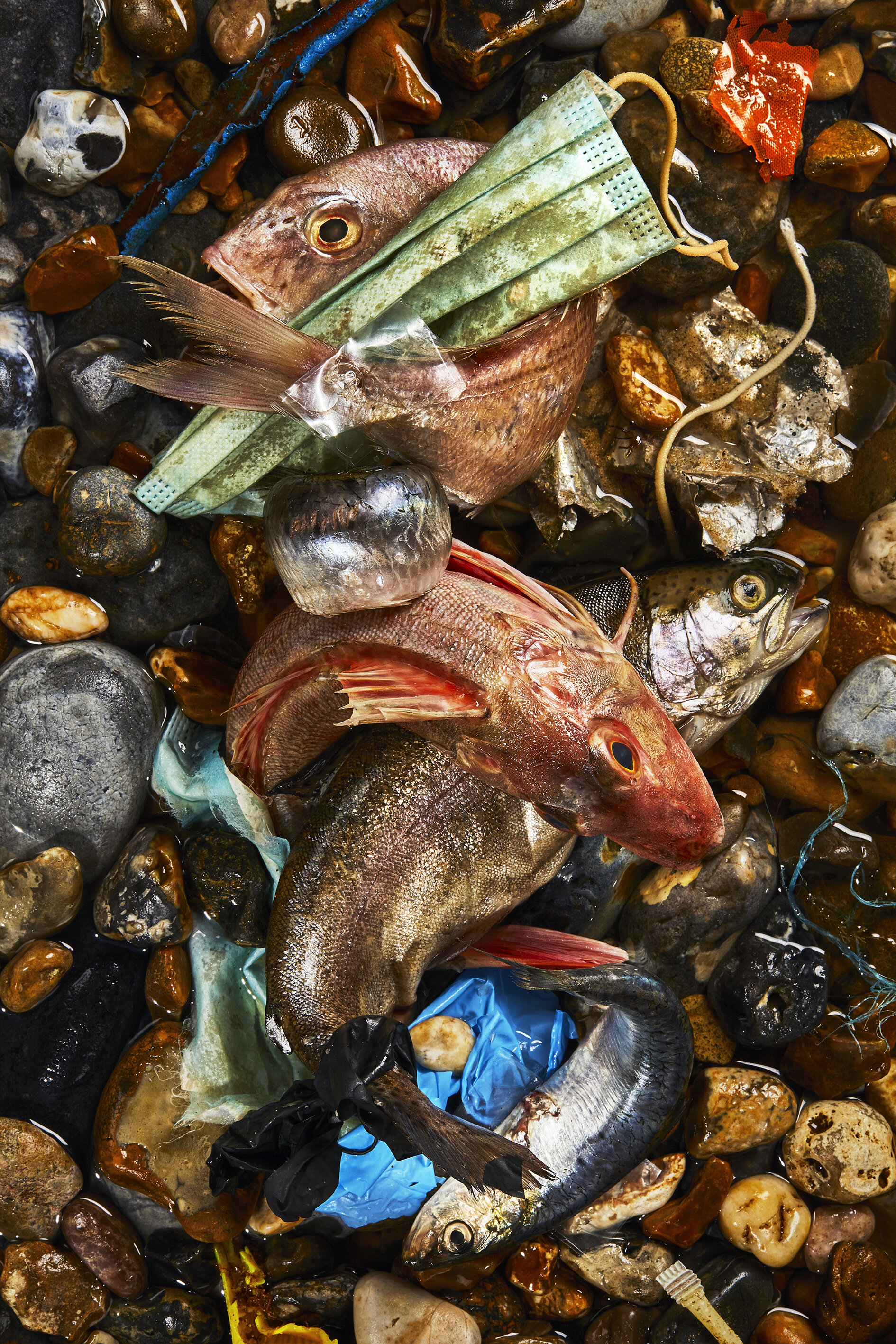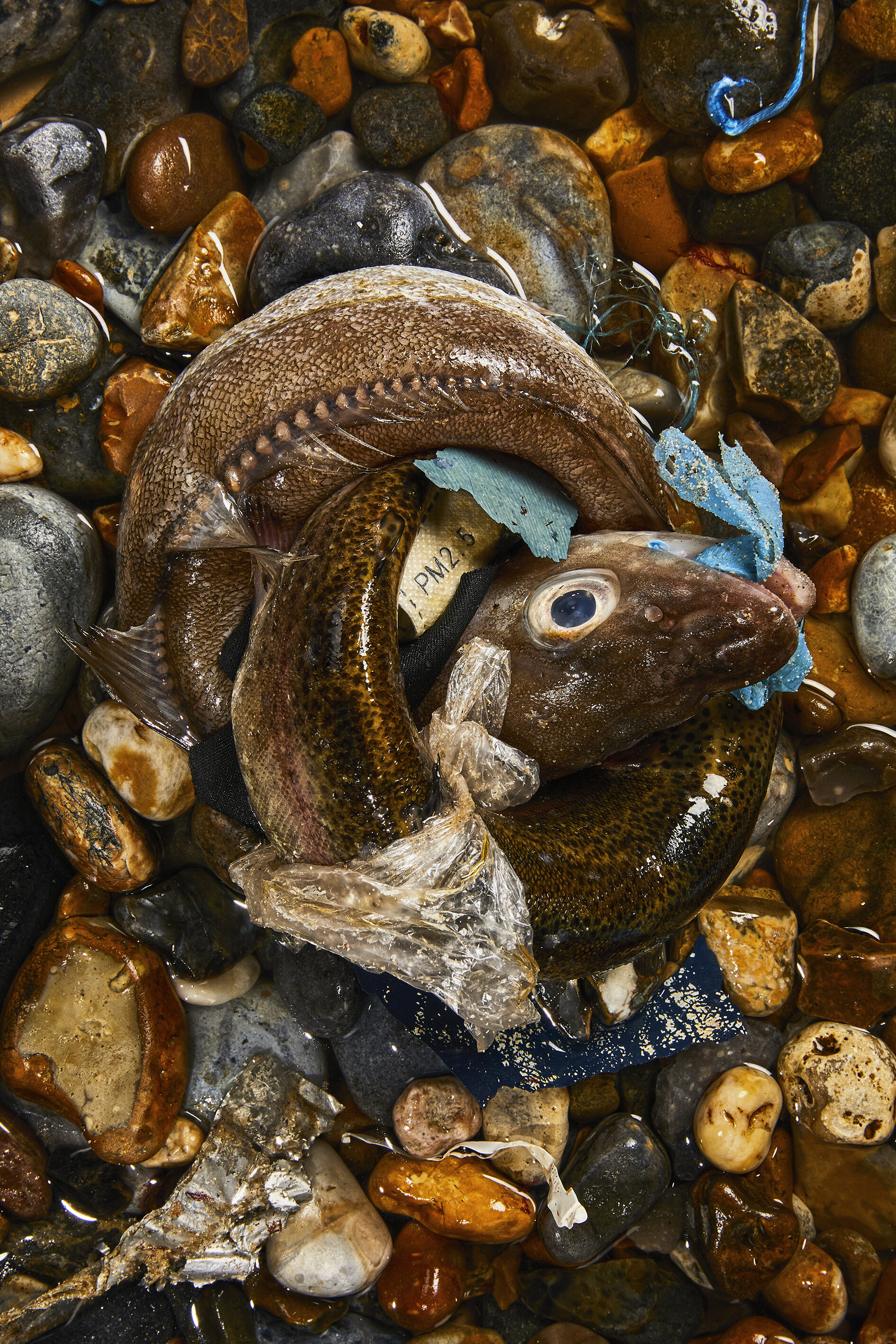P.P.E. Plastic Pollution Emergency PHOTOS_ Tim Atkins, SET DESIGN_ Elena Horn, WORDS & FOOD STYLE_ Iain Graham
PPE, gurnard, sardines, bream, LDP string, latex gloves, lemon sherbert and polypropylene waste
Face masks and gloves are now a part of daily life, they are compulsory in most situations, shops, buses, trains, even the school drop off.
After early worries about their effectiveness, people are now widely using face covering of all kinds, both to protect themselves and others by reducing the range of the water droplets from their breath.
The Pandemic has caused a tidal wave of used face masks and gloves now littering the streets, our PPE has become the new plastic bag. Not only this but lots of initiatives to halt the use of single use plastic have been stopped or relaxed. The PPE that litters our streets finds its way into the streams, rivers and drains and eventually to the ocean in much the same way as our single use plastic did.
The prophecy that there will be more plastic than fish in the ocean by 2050 looks like it will be coming true sooner rather than later.
Ocean trout and surgical mask
If every person in the UK wore a single use mask each day for a year it would generate over 84,000 tonnes of waste per year. Multiply that up by a small percentage of the worlds population and you have a scary and staggering number and that’s on top of the 8 million tonnes of plastic already dumped into the ocean each year.
John Dory, Mackerel, mullet, cotton bud, face mask, filter, blue latex glove and HDPE spoon
Cellulose based visors, which need very specific conditions to compost are also becoming part of the problem rather than the solution they were hailed as being. As with bio plastics, vegware and all of the other bio plastic recyclables, they are designed to breakdown over 12 weeks under controlled, commercial, composting conditions and are not designed to breakdown in an ocean.
Oil based plastics are now being heavily promoted by their producers, being used as a psychological virus proof safety barrier for food, cutlery and what ever else the producers can think of. Ironically Corona virus is able to survive far longer on plastic, than it can on fibrous natural surfaces.
Whiting, trout, Poly vinyl chloride, low density Polyethylene, PM2.5 face mask filter
From reusable cups to plastic bags, there is misinformation fuelling a surge in single use plastics and excessive use of PPE.
The solution for PPE users, which we all are now, is the same as for that of our plastic use. Single use is now not a solution. Reusable is the only way forward. Reusable coffee cups are safe for your barista, washed in hot soapy water they pose no risk to your local coffee shop workers. A washable, reusable face covering, works just as well as a single use surgical mask. We are so adaptable and so able to change that there is no reason that all our progress and hard work should come undone now.
Denton snapper and black latex kitchen glove
Tim, Myself and Elena were all concerned with PPE pollution and having all worked together before on projects against plastic pollution we really wanted to illustrate the dangers of PPE. We created this series of images, to show that river bed pollution is as much of a menace as that of the beach and oceans. Our aim was to produce something that showed the natural beauty of the fish and yet the grotesque and destructive face of the pollution.
In this shoot we used:
400g Mackerel
300g John Dory
600g Whiting
258g River Trout
263g Denton Snapper
295g Sardines
300g Red Mullet and 200g Anchovy were used that were about to be thrown away after not being sold.
John Dory, Monkfish, Gurnard, Cod, Bream and Seabass were all taken home and eaten by the Team.
Fish was purchased from The Fin and flounder, London Fields, using day boats in Cornwall and Sutton and Sons, Stoke Newington.
The Mackerel was cooked and reused for another shoot.
PPE was sourced from the Norfolk coast and London streets.
Lunch on the shoot was purchased, plastic free from local shops in Hackney.
Mackerel and polystyrene







